Fauna of India

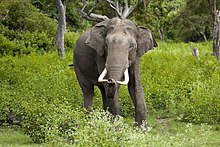
| Wildlife of India |
|---|
 |
India, for the most part, lies within the Indomalayan realm, with the upper reaches of the Himalayas forming part of the Palearctic realm; the contours of 2000 to 2500m are considered to be the altitudinal boundary between the Indo-Malayan and Palearctic zones. India displays significant biodiversity. One of seventeen megadiverse countries, it is home to 7.6% of all mammalian, 12.6% of all avian, 6.2% of all reptilian, 4.4% of all amphibian and 11.7% of all fish.
The region is also heavily influenced by summer monsoons that cause major seasonal changes in vegetation and habitat. India forms a large part of the
India is home to several well-known large mammals, including the Asian elephant, Bengal tiger, Asiatic lion, Indian leopard and Indian rhinoceros. Some of these animals are engrained in Indian culture, often being associated with deities. These large mammals are important for wildlife tourism in India, with several national parks and wildlife sanctuaries catering to these needs. The popularity of these charismatic animals have greatly helped conservation efforts in India. The tiger has been particularly important, and Project Tiger, started in 1972, was a major effort to conserve the tiger and its habitats.[8] Project Elephant, though less known, started in 1992 and works for elephant protection.[9] Most of India's rhinos today survive in the Kaziranga National Park.
Some other well-known large Indian mammals are ungulates such as the
The majority of conservation research attention on wildlife in India is focused within protected areas, though there is considerable wild fauna outside such reserves including in farmlands and in cities.[10][11][12]
Fauna of India
This article contains too many pictures for its overall length. |

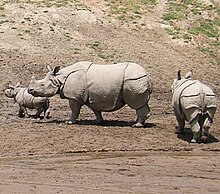

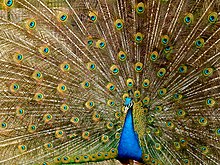
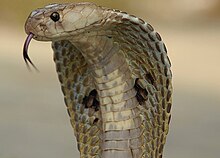


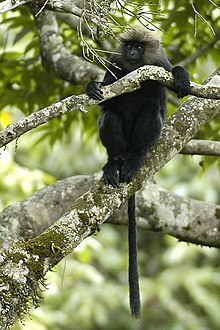
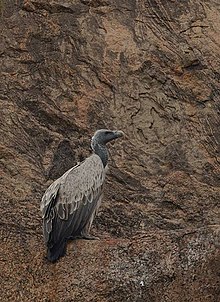
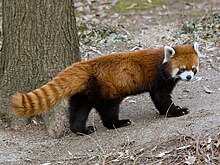
The Zoological Survey of India (ZSI), with its headquarters in Kolkata (the capital of West Bengal) and 16 regional stations is responsible for surveying the faunal resources of India. Possessing a tremendous diversity of climate and physical conditions, India has great variety of fauna, numbering 89,451 species.
The mammals include the
Several birds, like
There are several species of small mammals in India. These include the Asian house shrew, the northern and greater hog badger, the Chinese ferret-badger, the honey badger, the Indian pangolin, and the Chinese pangolin. Arboreal small mammals include the Nilgiri marten, small-toothed palm civet, Asian palm civet, small Indian civet, large Indian civet, binturong, and red panda. The bears of India are sun bear, sloth bear, Himalayan black bear, and Himalayan brown bear.
There are also many primates in India. The
Many animals are domesticated in India, and seeing them in the streets of villages and even cities is common. Bovines include the
Rivers and lakes harbour
Fish are a major part of the Indian economy. The fish include
Marine dolphins along the coast of India include bottlenose dolphin, common dolphin, and pantropical spotted dolphin among others. Finless porpoise are found along the coast as well. The endangered Irrawaddy dolphin is found in freshwater areas, such as Chilika Lake, alongside the Ganges river dolphin and Indus river dolphin. Blue whales, humpback whales, sperm whales, dwarf sperm whales, fin whales, orcas, Cuvier's beaked whales, and pygmy killer whales are the most common whales. The semi-aquatic mammals in India are otters. The species of otters are Asian small-clawed otter, Eurasian otter, and smooth-coated otter. The increasingly endangered dugong is found throughout coastal estuaries and brackish water bodies.
A notable dragonfly is the
Stegodon elephants, Indosaurus, Himalayan quail, and pink-headed duck are famous extinct animals from India. The Himalayan quail and pink-headed duck are only presumed extinct. However, there are other quails such as rain quail in India, and the pink-headed duck's relative the Indian spot-billed duck.
Depletion of vegetative cover due to expansion of agriculture, habitat destruction, over-exploitation, pollution, introduction of toxic imbalance in community structure, epidemics, floods, droughts and cyclones, contribute to the loss of flora and fauna. More than 39 species of mammals, 72 species of birds, 17 species of reptiles, three species of amphibians, two species of fish, and a large number of butterflies, moth, and beetles are considered vulnerable and endangered.[13]
Biodiversity
India is listed 12th among the
There is insufficient information about the invertebrate fauna of India, with significant work having been done only in a few groups of insects, notably the butterflies, Odonata and Hymenoptera, mostly in The Fauna of British India, Including Ceylon and Burma series.
There are about 2,546 species of fishes (about 11% of the world species) found in Indian waters. About 197 species of amphibians (4.4% of the world total) and more than 408 reptile species (6% of the world total) are found in India. Among these groups the highest levels of endemism are found in the amphibians.
There are about 1361 species of birds recorded from India, with some variations, depending on taxonomic treatments, accounting for about 12% of the world species.[14]
There are about 410 species of mammals known from India, which is about 8.86% of the world species.[15]
India has the greatest number of cat species in the world.[16]
The World Conservation Monitoring Centre gives an estimate of about 15,000 species of flowering plants in India.
Biodiversity hotspots
The Western Ghats
The Western Ghats are a chain of hills that run along the western edge of peninsular India. Their proximity to the ocean and through orographic effect, they receive high rainfall. These regions have moist deciduous forest and rain forest. The region shows high species diversity as well as high levels of endemism. Nearly 77% of the amphibians and 62% of the reptile species found here are found nowhere else.[17] The region shows biogeographical affinities to the Malayan region, and the Satpura hypothesis proposed by Sunder Lal Hora suggests that the hill chains of Central India may have once formed a connection with the forests of northeastern India and into the Indo-Malayan region. Hora used torrent stream fishes to support the theory, but it was also suggested to hold for birds.[18] Later studies have suggested that Hora's original model species were a demonstration of convergent evolution rather than speciation by isolation.[17]
More recent phylogeographic studies have attempted to study the problem using molecular approaches.[19] There are also differences in taxa which are dependent on time of divergence and geological history.[20] Along with Sri Lanka this region also shows some fauna similarities with the Madagascan region especially in the reptiles and amphibians. Examples include the Sinophis snakes, the purple frog and Sri Lankan lizard genus Nessia which appears similar to the Madagascan genus Acontias.[21] Numerous floral links to the Madagascan region also exist.[22] An alternate hypothesis that these taxa may have originally evolved out-of-India has also been suggested.[23]
Bio geographical quirks exist with some taxa of Malayan origin occurring in Sri Lanka but absent in the Western Ghats. These include insects groups such as the plants such as those of the genus Nepenthes.
The Eastern Himalayas
The Eastern Himalayas is the region encompassing
Extinct and fossil forms
During the early Tertiary period, the Indian tableland, what is today peninsular India, was a large island. Prior to becoming an island, it was connected to the African region. During the tertiary period, this island was separated from the Asian mainland by a shallow sea. The Himalayan region and the greater part of Tibet lay under this sea. The movement of the Indian subcontinent into the Asian landmass created the great Himalayan ranges and raised the sea bed into, what is today, the plains of northern India.
Once connected to the Asian mainland, many species moved into India. The Himalayas were created in several upheavals. The Siwaliks were formed at the last and the largest number of fossils of the Tertiary period are found in these ranges.[27]
The Siwalik fossils include
Many fossil tree species have been found in the intertrappean beds,
Some fossil snakes from the Cenozoic era are also known.[33]
Some scientists have suggested that the Deccan lava flows and the gases produced were responsible for the global extinction of dinosaurs. However, these have been disputed.[34][35]
Several small mammal fossils have been recorded in the intertrappean beds, however larger mammals are mostly unknown. The only major primate fossils have been from the nearby region of Myanmar.
- See also Geology of India
Recent extinctions
The exploitation of land and forest resources by humans along with hunting and trapping for food and sport has led to the extinction of many species in India in recent times.[citation needed]
Probably the first species to vanish during the time of the Indus Valley civilisation was the species of wild cattle, Bos primegenius nomadicus or the wild
Notable mammals which became or are presumed extinct within the country itself include the Indian / Asiatic cheetah, Javan rhinoceros and Sumatran rhinoceros.[39] While some of these large mammal species are confirmed extinct, there have been many smaller animal and plant species whose status is harder to determine. Many species have not been seen since their description. Hubbardia heptaneuron, a species of grass that grew in the spray zone of the Jog Falls prior to the construction of the Linganamakki reservoir, was thought to be extinct but a few were rediscovered near Kolhapur.[40]
Some species of birds have gone extinct in recent times, including the
Species estimates

An estimate of the numbers of species by group in India is given below. This is based on Alfred, 1998.[43]
| Taxonomic group | World species | Indian species | % in India |
| PROTISTA | |||
| Protozoa | 31250 | 2577 | 8.24 |
| Total (Protista) | 31250 | 2577 | 8.24 |
| ANIMALIA | |||
| Mesozoa | 71 | 10 | 14.08 |
| Porifera | 4562 | 486 | 10.65 |
| Cnidaria | 9916 | 842 | 8.49 |
| Ctenophora | 100 | 12 | 12 |
| Platyhelminthes | 17500 | 1622 | 9.27 |
| Nemertinea | 600 | ||
| Rotifera | 2500 | 330 | 13.2 |
| Gastrotricha | 3000 | 100 | 3.33 |
| Kinorhyncha | 100 | 10 | 10 |
| Nematoda | 30000 | 2850 | 9.5 |
| Nematomorpha | 250 | ||
| Acanthocephala | 800 | 229 | 28.62 |
| Sipuncula | 145 | 35 | 24.14 |
| Mollusca | 66535 | 5070 | 7.62 |
| Echiura | 127 | 43 | 33.86 |
| Annelida | 12700 | 840 | 6.61 |
| Onychophora | 100 | 1 | 1 |
| Arthropoda | 987949 | 68389 | 6.9 |
| Crustacea | 35534 | 2934 | 8.26 |
| Insecta | 853000 | 53400 | 6.83 |
| Arachnida | 73440 | 7.9 | |
| Pycnogonida | 600 | 2.67 | |
| Pauropoda | 360 | ||
| Chilopoda | 3000 | 100 | 3.33 |
| Diplopoda | 7500 | 162 | 2.16 |
| Symphyla | 120 | 4 | 3.33 |
| Xiphosura | 4 | 2 | 50 |
| Phoronida | 11 | 3 | 27.27 |
| Bryozoa (Ectoprocta) | 4000 | 200 | 5 |
| Endoprocta | 60 | 10 | 16.66 |
| Brachiopoda | 300 | 3 | 1 |
| Pogonophora | 80 | ||
| Praipulida | 8 | ||
| Pentastomida | 70 | ||
| Chaetognatha | 111 | 30 | 27.02 |
| Tardigrada | 514 | 30 | 5.83 |
| Echinodermata | 6223 | 765 | 12.29 |
| Hemichordata | 120 | 12 | 10 |
| Chordata | 48451 | 4952 | 10.22 |
| Protochordata (Cephalochordata+Urochordata) | 2106 | 119 | 5.65 |
| Pisces | 21723 | 2546 | 11.72 |
| Amphibia | 7533 | 350 | 4.63 |
| Reptilia | 5817 | 456 | 7.84 |
| Aves | 9026 | 1232 | 13.66 |
| Mammalia | 4629 | 390 | 8.42 |
| Total (Animalia) | 1196903 | 868741 | 7.25 |
| Grand total (Protosticta+Animalia) | 1228153 | 871318 | 7.09 |
Taxonomic lists and indices



This section provides links to lists of species of various taxa found in India.
Animals
Invertebrates
- Molluscs
- Arachnids
- Insects
- Odonata
- Dragonflies and damselflies of India
- Lepidoptera
- Hymenoptera
- Odonata
Vertebrates
- Fishes of India
- Amphibians of India
- Reptiles of India
- Birds of South Asia
- Birds in India
- Mammals of India
See also
- Ecoregions in India
- Endangered Mammals of India
- Fauna of British India, Including Ceylon and Burma
- Flora of India
- List of Indian state birds
- Wildlife of India
- Other related
- Indian natural history
- Endemic birds of South Asia
- Indian Council of Forestry Research and Education
- India Nature Watch
References
- ^ a b India adds 557 new species to its fauna: Zoological Survey of India Archived 13 September 2021 at the Wayback Machine, The Hindu, 27 Aug 2021.
- ^ Bagli, Katie (31 May 2021). "Here's a look at 6 biodiversity hotspots of India". The Hindu.
- ^ [1] Archived 9 November 2005 at the Wayback Machine
- ^ Jean-Claude Rage (2003) Relationships of the Malagasy fauna during the Late Cretaceous: Northern or Southern routes? Acta Palaeontologica Polonica 48(4):661-662 PDF Archived 14 December 2004 at the Wayback Machine
- ^ Briggs, JC (2003) The biogeographic and tectonic history of India. Journal of Biogeography, 30:381–388
- ^ Marivaux L., Welcome J.-L., Antoine P-O., Métais G., Baloch I.M., Benammi M., Chaimanee Y., Ducrocq S., and Jaeger J.-J. (2001) A fossil lemur from the Oligocene of Pakistan. Science, 294: 587–591.
- ^ Oligocene Lemur fossil hints at Asian origin Archived 6 October 2017 at the Wayback Machine. Retrieved February 2007.
- ^ Project Tiger Archived 11 February 2016 at the Wayback Machine Accessed Feb, 2007
- ^ Project Elephant Archived 19 January 2007 at the Wayback Machine Accessed Feb, 2007
- .
- S2CID 252193648.
- S2CID 19183508.
- ^ Hawk, Indian (2021). "Fauna of India". Know India. Archived from the original on 19 August 2017.
- ^ WCMC website Archived 28 November 2001 at the Library of Congress Web Archives
- ^ Nameer, P. O. (1998). Checklist of Indian mammals. Thiruvananthapuram: Kerala Forest Department.
- ISBN 9781461408000.
- ^ a b Daniels, R. J. R. (2001) Endemic fishes of the Western Ghats and the Satpura hypothesis Archived 3 March 2016 at the Wayback Machine. Current Science 81(3):240-244
- ^ Ripley, Dillon S. (1947) Avian relicts and double invasions in Peninsular India and Ceylon(Sri Lanka) Archived 5 December 2022 at the Wayback Machine. Evolution 2:150–159
- ^ Karanth, P. K. (2003) Evolution of disjunct distributions among wet-zone species of the Indian subcontinent: Testing various hypotheses using a phylogenetic approach Archived 16 December 2018 at the Wayback Machine Current Science, 85(9): 1276-1283
- ^ Biswas, S. and Pawar S. S. (2006) Phylogenetic tests of distribution patterns in South Asia: towards an integrative approach Archived 16 December 2018 at the Wayback Machine; J. Biosci. 31 95–113
- ^ "affinities". Archived from the original on 4 March 2016. Retrieved 30 August 2006.
- ^ "Bio geography of Madagascar". Archived from the original on 18 January 2019. Retrieved 6 September 2006.
- ^ Karanth, P. 2006 Out-of-India Gondwanan origin of some tropical Asian biota Archived 11 April 2019 at the Wayback Machine. Current Science 90(6):789-792
- ^ Conservation International 2006 Archived 25 August 2006 at the Wayback Machine
- ^ Ecosystem Profile: Eastern Himalayas Region Archived 28 September 2011 at the Wayback Machine, 2005
- ^ Amphibian Species of the World - Desmognathus imitator Dunn, 1927 Archived 10 March 2007 at the Wayback Machine
- ^ a b Prater, S. H. (1971) The Book of Indian Animals. BNHS
- ^ Stewart R. Hinsley Notes on fossil wood Archived 19 November 2017 at the Wayback Machine. Retrieved September 2006.
- ^ Robert Buckler (1999) A brief review of the fossil cycads. PDF Archived 24 February 2012 at the Wayback Machine
- ^ "Royal Botanical Gardens, Sydney, Australia". Archived from the original on 1 April 2019. Retrieved 10 August 2006.
- ^ Singh, Rita, P. Radha (2006) A new species of Cycas from the Malabar Coast, Western Ghats, India. Volume 58(2):119-123
- ^ Rajasaurus and Indian Dinosaur. Geological Survey of India. PDF Archived 28 May 2008 at the Wayback Machine
- ^ Rage J.-C., Bajpai S., Thewissen J. G. M. & Tiwari B. N. 2003. Early Eocene snakes from Kutch, Western India, with a review of the Palaeophiidae. Geodiversitas 25 (4) : 695-716 PDF Archived 21 February 2012 at the Wayback Machine
- ^ "Floodvolcanism is the main cause of mass extinctions: Nice try, but where is the evidence? PDF" (PDF). Archived (PDF) from the original on 1 December 2017. Retrieved 21 February 2006.
- ^ Volcanism Archived 4 May 2006 at the Wayback Machine
- ^ "Whale fossils". Archived from the original on 16 December 2018. Retrieved 21 February 2006.
- ^ Bajpai, S. and Gingerich P.D. (1998) A new Eocene archaeocete (Mammalia, Cetacea) from India and the time of origin of whales Proc. Natl. Acad. Sci. USA 95:15464–15468 PDF Archived 22 December 2005 at the Wayback Machine
- ISBN 81-7824-140-4
- ISBN 0-14-302998-3.
- ^ IUCN Species Survival Commission (SSC) E-Bulletin - December 2002. Retrieved October 2006.
- ^ Threatened birds of Asia Archived 13 October 2006 at the Wayback Machine. Retrieved October 2006.
- ^ The Nation, March 6, 2007 Archived 27 May 2007 at the Wayback Machine
- ^ Alfred, J.R.B. (1998) Faunal Diversity in India: An Overview: In Faunal Diversity in India, i-viii Archived 10 April 2009 at the Wayback Machine, 1-495. (Editors. Alfred, JRB, et al., 1998). ENVIS Centre, Zoological Survey of India, Calcutta.
Further reading
- SPECIES CHECKLIST: Species Diversity in India; ENVIS Centre: Wildlife & Protected Areas (Secondary Database); Wildlife Institute of India (WII)
- Biodiversity of India: List of all mammals of India and their taxonomic status based on data from the IBIN Portal, Encyclopedia of Life and Catalogue of Life 2010 checklist.
- ENVIS Centre: Wildlife & Protected Areas (Secondary Database); Wildlife Institute of India (WII)
- ENVIS Centre on Conservation of Ecological Heritage and Sacred Sights of India Archived 12 January 2019 at the Wayback Machine; ENVIS; C.P.R. Environmental Education Centre is a Centre of Excellence of the Ministry of Environment and Forests, Government of India.
External links
- Tata Energy Research Institute Archived 30 April 2018 at the Wayback Machine
- Alliance for Zero extinction Archived 15 December 2005 at the Wayback Machine
- The official Indian Environment information site
- Biodiversity of India, a community-driven, Mediawiki based initiative to document the biodiversity of India.




